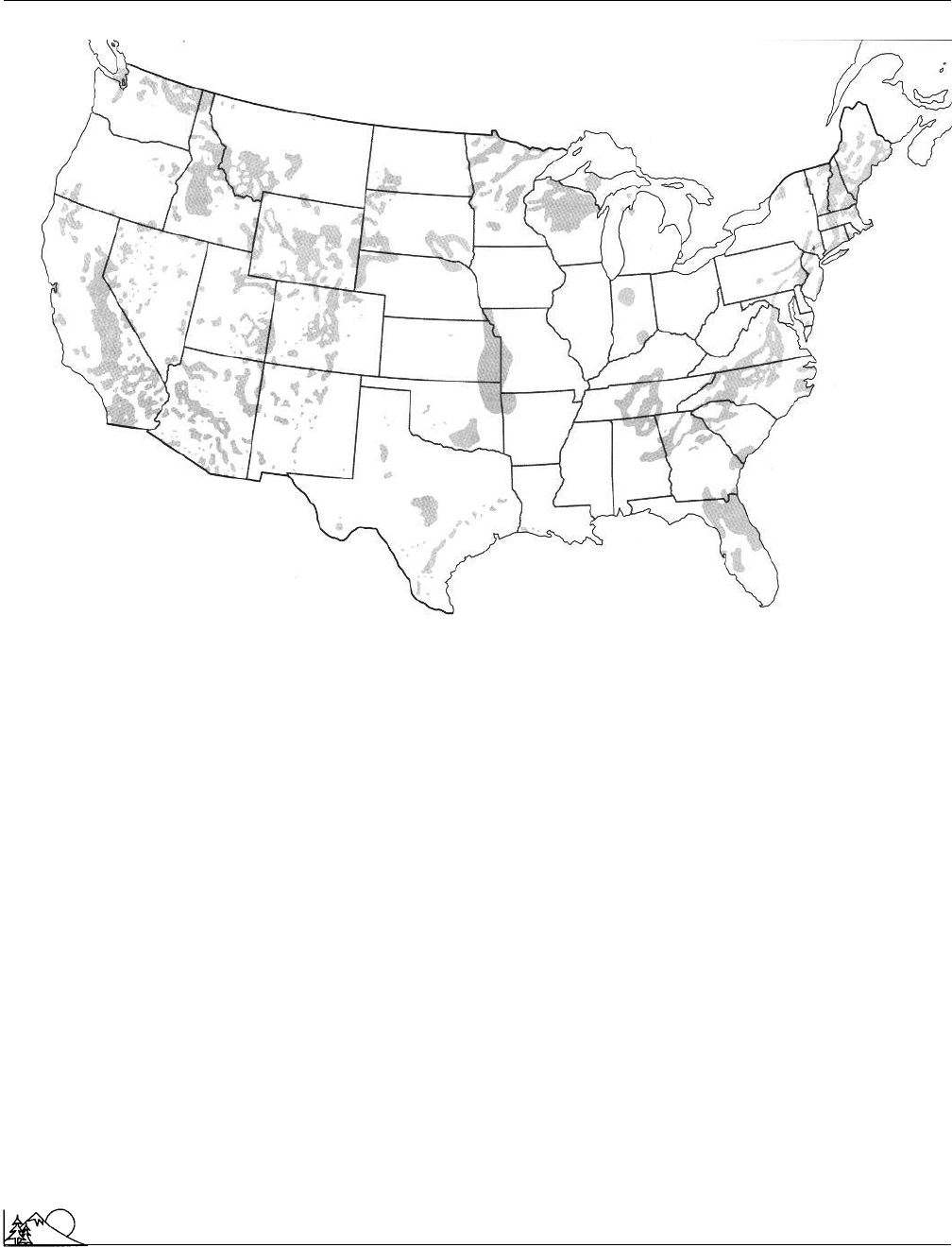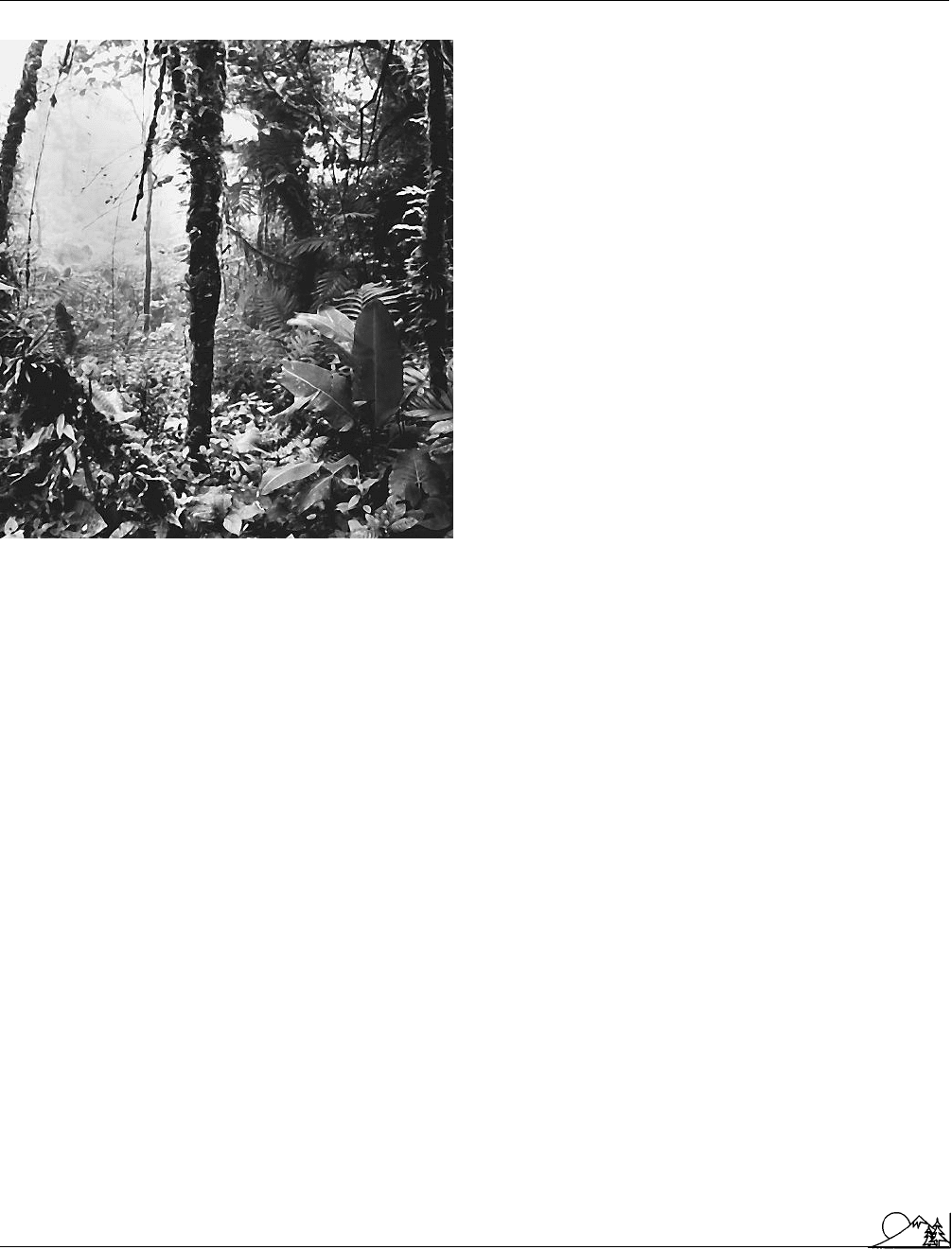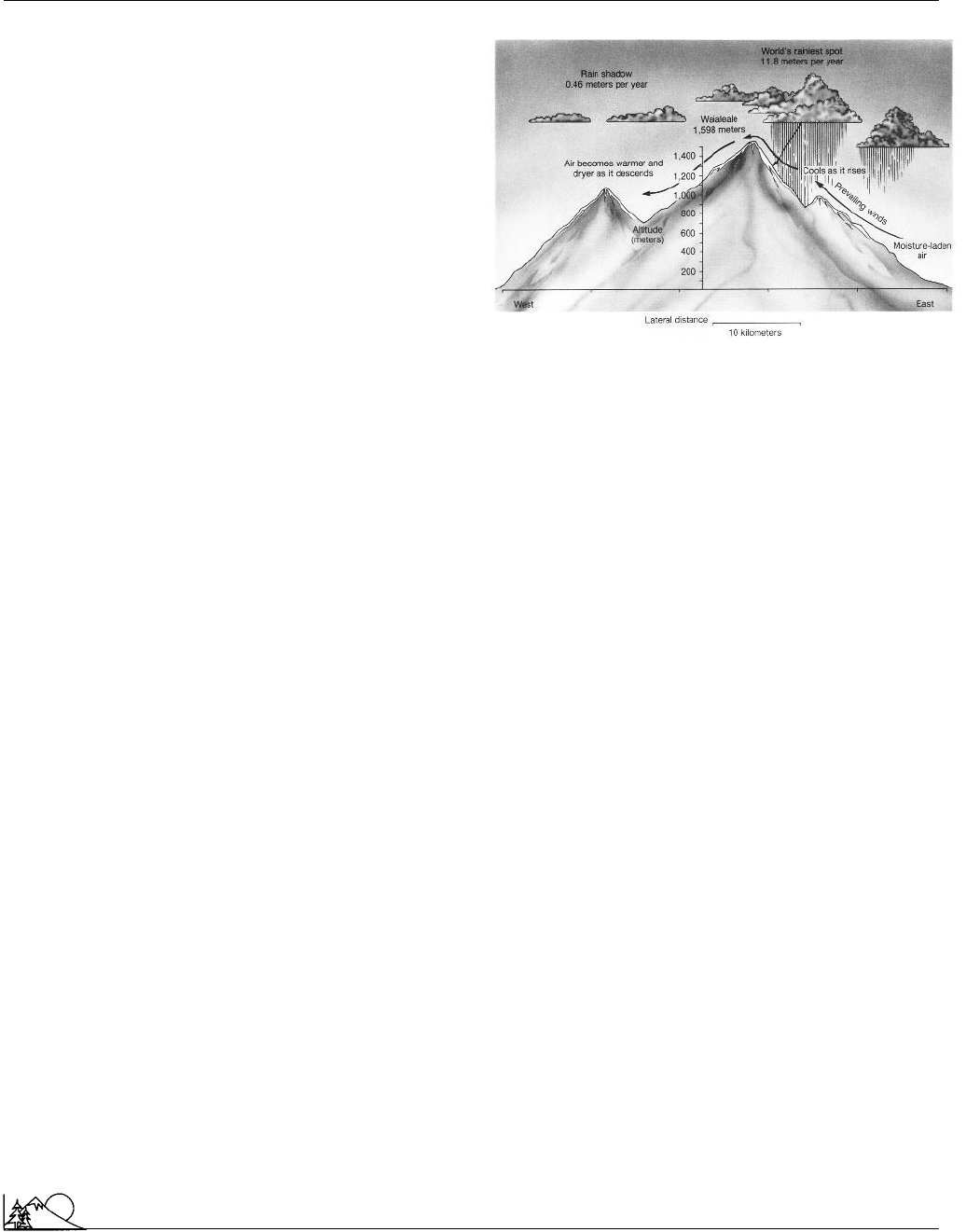Environmental Encyclopedia
Подождите немного. Документ загружается.


Environmental Encyclopedia 3
Rails-to-Trails Conservancy
The shaded areas on the map have potentially high levels of uranium in the soil and rocks. Radon levels may
be high in these areas. (McGraw-Hill Inc. Reproduced by permission.)
dying the problem. See also Radiation exposure; Radioactive
decay; Radioactive pollution; Radioactivity
[Usha Vedagiri]
R
ESOURCES
B
OOKS
Brenner, D. J. Radon: Risk and Remedy. Salt Lake City: W. H. Free-
man, 1989.
Cohen, B. Radon: A Homeowner’s Guide to Detection and Control. Mt.
Vernon, NY: Consumer Report Books, 1988.
Kay, J. G., et al. Indoor Air Pollution: Radon, Bioaerosols, and VOCs. Chelsea,
MI: Lewis, 1991.
Lafavore, M. Radon: The Invisible Threat. Emmaus, PA: Rodale Press, 1987.
Rails-to-Trails Conservancy
In 1985, the Rails-to-Trails Conservancy, a non-profit orga-
nization, was established to convert abandoned railroad cor-
ridors into open spaces for public use. During the nineteenth
century, the railroad industry in the United States boomed
1167
as rail companies rushed to acquire land and assemble the
largest rail system in the world. By 1916, over 250,000
mi (402,000) of track had been laid across the country,
connecting even the most remote towns to the rest of the
nation. However, during the next few decades, the
automo-
bile
drastically changed the way Americans live and travel.
With Henry Ford’s introduction of mass production
techniques, the automobile became affordable for nearly ev-
eryone, and industry shifted to trucking for much of its
overland
transportation
. The invention and widespread use
of airplanes had a significant impact on the railroad industry
as well, and people began abandoning railroad transpor-
tation.
As a result of these developments, thousands of miles
of rail corridors fell into disuse. Rails-to-Trails Conservancy
estimates that over 3,000 mi (4,828 km) of track are aban-
doned each year. Since much of the track is in the public
domain, Rails-to-Trails strives to find uses for the land that
will benefit the public. Thus Rails-to-Trails works with
citizen groups, public agencies, railroads, and other con-
cerned parties to, according to the organization, “build a

Environmental Encyclopedia 3
Rain forest
transcontinental trailway network that will preserve for the
future our nation’s spectacular railroad corridor system.”
Some of the rails have been converted to trails for
hiking, biking, and cross-country skiing as well as
wildlife
habitats. By providing people with information about up-
coming abandonments, assisting public and private agencies
in the effort to gain control of those lands, sponsoring short-
term land purchases, and working with Congress and other
federal and state agencies to simplify the acquisition of aban-
doned railways, Rails-to-Trails has mobilized a powerful
grassroots movement across the country. Today there are
over 11,500 mi (18,506 km) of converted rails-to-trails.
Rails-to-Trails also sponsors an annual conference and
other special meetings and publishes materials related to
railway
conservation
. Its quarterly newsletter, Trailblazer,
is sent to members and keeps them aware of rails-to-trails
issues. Many books and pamphlets are available through the
group, as are studies such as How to Get Involved with the
Rails-to-Trails Movement and The Economic Benefits of Rails-
to-Trails Conversions to Local Economies. In addition, the
Rails-to-Trails Conservancy provides legal support and ad-
vice to local groups seeking to convert rails to trails.
[Linda M. Ross]
R
ESOURCES
O
RGANIZATIONS
Rails-to-Trails Conservancy. 1100 17th Street, 10th Floor, NW,
Washington, D.C. USA 20036. (202) 331-9696, Email:
railtrails@transact.org, <http://www.railtrails.org>.
Rain forest
The world’s rain forests are the richest ecosystems on Earth,
containing an incredible variety of plant and animal life.
These forests play an important role in maintaining the
health and
biodiversity
of the planet. But rain forests
throughout the world are rapidly being destroyed, threaten-
ing the survival of millions of
species
of plants and animals
and disrupting
climate
and weather patterns. The rain for-
ests of greatest concern are those located in tropical regions,
particularly those found in Central and South America, and
the ancient temperate rain forests along the northeastern
coast of North America.
Tropical rain forests (TRFs) are amazingly rich and
diverse biologically and may contain one-half to two-thirds
of all species of plants and animals, though these forests
cover only about 5–7% of the world’s land surface. Tropical
rain forests are found near the equatorial regions of Central
and South America, Africa, Asia, and on Pacific Islands,
with the largest remaining forest being the Amazon rain
forest, which covers a third of South America.
1168
TRFs remain warm, green, and humid throughout the
year and receive at least 150 in (4 m) of rain annually, up
to half of which may come from trees giving off water
through the pores of their leaves in a process called
transpi-
ration
. The tall, lush trees of the forest form a two- to
three-layer closed canopy, allowing very little light to reach
the ground. Although tropical forests are known for their
lush, green vegetation, the
soil
stores very few nutrients.
Dead and decomposing animals, trees, and leaves are quickly
taken up by forest organisms, and very little is absorbed into
the ground.
In 1989 World Resources Institute predicted that “be-
tween 1990 and 2020, species extinctions caused primarily
by tropical
deforestation
may eliminate somewhere be-
tween 5–15% of the world’s species...This would amount to
a potential loss of 15,000 to 50,000 species per year, or 50
to 150 species per day.” It is estimated that 30–80 million
species of insects alone may exist in TRFs, at least 97% of
which have never been identified or even discovered.
Tropical forests also provide essential winter
habitat
for many birds that breed and spend the rest of the year in
the United States. Some 250 species found in the United
States and Canada spend the winter in the tropics, but their
population levels are decreasing alarmingly due to forest
depletion.
Tropical rain forests have unique resources, many of
which have yet to be utilized. Food, industrial products, and
medicinal supplies are common examples. Among the many
fruits, nuts, and vegetables that we use on a regular basis
and which originated in tropical forests are citrus fruits,
coffee, yams, nuts, chocolate, peppers, and cola. A variety
of oils, lubricants, resins, dyes, and steroids are also products
of the forests. Natural
rubber
, the fourth biggest agricultural
export of southeast Asian nations, brings in over $3 billion
a year to developing countries. The forests could also yield
a sustainable supply of woods like teak, mahogany, bamboo,
and others. Although only about 1% of known tropical plants
have been studied for medicinal or pharmaceutical applica-
tions, these have produced 25–40% of all prescription drugs
used in the United States. Some 2,000 tropical plants now
being studied have shown potential as cancer-fighting
agents.
Scientists studying ways to commercially utilize these
forests in a sustainable, non-destructive way have determined
that two to three times more money could be made from
the long-term collection of such products as nuts, rubber,
medicines, and food, as from cutting the trees for
logging
or cattle ranching. Perhaps the greatest value of tropical rain
forests is the essential role they play in the earth’s climate. By
absorbing
carbon dioxide
and producing oxygen through
photosynthesis
, the forests help prevent global warming

Environmental Encyclopedia 3
Rain forest
(the
greenhouse effect
) and are important in generating
oxygen for the planet. The forests help prevent droughts and
flooding
, soil
erosion
and stream
sedimentation
, maintain
the
hydrologic cycle
, and keep streams and rivers flowing
by absorbing rainfall and releasing moisture into the air.
Despite the worldwide outcry over deforestation, de-
struction is actually increasing. A 1990 study by the United
Nations Food and Agriculture Organization found that trop-
ical forests were disappearing at a rate exceeding 40 million
acres (16.2 million ha) a year—an area the size of Washing-
ton state. This rate is almost twice that of the previous
decade.
Timber companies in the United States and western
Europe are responsible for most of this destruction, mainly
through farming, cattle ranching, logging, and huge develop-
ment projects. Japan, the world’s largest hardwood importer,
buys 40% of the timber produced, with the United States a
close second. Ironically, much of the destruction of forests
worldwide has been paid for by American taxpayers through
such government-funded international lending and develop-
ment agencies as the
World Bank
, the International Mone-
tary Fund, and the Inter-American Development Bank,
along with the United States Agency for International De-
velopment.
The release of the World Bank’s new Operational
Policy on Forests has been delayed since October 2001, and
had not been released as of the first week in July 2002. The
release has been delayed by a World Bank dispute over
whether its new Forest Policy would apply to the World
Bank’s growing area of lending, which directly or indirectly
finances logging activities. There has been widespread de-
mand that the Forest Policy must apply to all World Bank
operations that might have an impact on forests. It remains
to be seen how the Operational Policy on Forests will handle
this important question.
American, European, and Latin American demand
for beef has contributed heavily to the conversion of rain
forest to pasture land. It is estimated that one-fourth of all
tropical forests destroyed each year are cut and cleared for
cattle ranching. Between 1950 and 1980, two-thirds of Cen-
tral America’s primary forests were cut, mostly to supply the
United States with beef for fast food outlets and pet food.
In Brazil and other parts of the
Amazon Basin
, cattle
ranchers, plantation owners, and small landowners clear the
forest by setting it on fire, which causes an estimated 23–
43% increase in
carbon
dioxide levels worldwide and spreads
smoke
over millions of square miles, which interferes with
air travel and causes respiratory difficulties.
Unfortunately, cleared forest that is turned into pasture
land provides very poor quality soil, which can only be
ranched for a few years before the land becomes infertile
and has to be abandoned. Eventually
desertification
sets
1169
in, causing cattle ranchers to move on to new areas of the
forest.
While huge timber and multi-national corporations
have justifiably received much of the blame for the destruc-
tion of TRFs, local people also play a major role. Populations
of the
Third World
gather wood for heating and cooking,
and the demand brought about by their growing numbers
has resulted in many deforested areas. The proliferation
of coca farms, producing cocaine mainly for the American
market, has also caused significant deforestation and
pollu-
tion
, as has gold prospecting in the Amazon.
The destruction of TRFs has already had devastating
effects on
indigenous peoples
in tropical regions. Entire
tribes, societies, and cultures have been displaced by environ-
mental damage caused by deforestation. In Brazil fewer than
200,000 Indians remain, compared to a population of some
six million about 400 years ago. Sometimes they are killed
outright when they come into contact with settlers, loggers,
or prospectors, either by disease or because they are shot.
And those who are not killed are often herded into miserable
reservations or become landless peasants working for slave
labor wages.
Today, less than 5% of the world’s remaining TRFs
have some type of protective status, and there is often little
or no enforcement of prohibitions against logging,
hunting
,
and other destructive activities.
The ancient rain forests of North America are also
important ecosystems, composed in large part of trees that
are hundreds and even thousands of years old. Temperate
rain forests (or evergreen forests) are usually composed of
conifers (needle-leafed, cone-bearing plants) or broadleaf
evergreen trees. They thrive in cool coastal climates with
mild winters and heavy rainfall and are found along the
coasts of the Pacific Northwest area of North America,
southern Chile, western New Zealand, and southeast
Aus-
tralia
, as well as on the lower mountain slopes of western
North America, Europe, and Asia.
The rain forest of the Pacific Northwest, the largest
coniferous forest
in the world, stretches over 112,000 mi
2
(129,000 km
2
) of coast from Alaska to northern California,
and parts extend east into mountain valleys. The forests of
the Pacific Northwest consist of several species of coniferous
trees, including varieties of spruce, cedar, pine, Douglas fir,
Hemlock, and Pacific yew. Broadleaf trees, such as Oregon
oak, tanoak, and madrone, are also found there. Redwood
tree growth extends to central California. Further south are
the giant sequoias, the largest living organisms on earth,
some of which are over 3,000 years old.
In some ways, the temperate rain forests of the Pacific
Northwest may be the most biologically rich in the world.
Although TRFs contain many more species, temperate rain

Environmental Encyclopedia 3
Rain forest
Rain forest. (Photograph by David Julian. Phototake
NYC. Reproduced by permission.)
forests have far more plant matter per acre and contain the
tallest and oldest trees on Earth. Over 210 species of fish
and
wildlife
live in ancient forests, and a single tree can
support over 100 different species of plants. One tree found
in cool, moist forests is the slow-growing Pacific yew, whose
bark and needles contain taxol, considered one of the most
powerful anti-cancer drugs ever discovered.
Unfortunately, the
clear-cutting
of most of the an-
cient forests and their yew trees has caused a serious shortage
of taxol. Some yew trees are unavailable for harvesting be-
cause they grow in forests protected as habitat for the endan-
gered
northern spotted owl
. The logging of federal land
under the jurisdiction of the
Bureau of Land Management
(BLM) and the U.S.
Forest Service
(USFS) has eliminated
some of the last and best habitats for the Pacific yew.
The remaining ancient forest, almost all of which is
now on BLM and USFS land, is being cut at a rate of
200,000 acres (81,000 ha) a year, as of 1992. At this rate it
will be destroyed within less than two decades. The conse-
quences of this destruction will include the disappearance
of
rare species
dependent on this habitat, the silting of
waterways and erosion of soil, and the decimation of
salmon
populations, which provide the world’s richest salmon fish-
ery, worth billions of dollars annually.
1170
Although the timber industry claims that logging
maintains jobs in the Pacific Northwest, logging
national
forest
often makes no economic sense. Because of the ex-
pense of building logging roads, surveying the area to be
cut, and the low price it charges for trees, the USFS often
loses money on its timber sales. As a result of such “deficit”
or “below cost” timber sales between 1989 and 1992, the
USFS lost an average of almost $300 million a year by selling
timber from national forests.
Several private
conservation
groups, such as the
Wil-
derness Society
and the
Sierra Club
, are working to pre-
serve the remaining ancient forests on BLM and USFS land
through federal legislation, lawsuits, and other actions. In
April 1993, President Bill Clinton attended a “timber sum-
mit” in Portland, Oregon, to discuss the ancient forests,
endangered species
, and timber jobs. But the cutting of old
growth forests and “below cost” timber sales have continued
much as before. The Bush administration has not supported
environmental issues. In 2001, President Bush triggered in-
ternational outrage when he refused to agree to the Kyoto
Protocol, a United Nations approved plan to preserve the
environment
.
Two of the largest remaining temperate rainforests are
Alaska’s 16.9 million-acre (6.8 million ha) Tongass National
Forest and the Russian
Taiga
. Tongass is the last large,
relatively undisturbed, temperate rain forest in the United
States, stretching over 600 mi (966 km) of coast along the
Alaska Panhandle. It has the highest concentration of bald
eagles and grizzly bears anywhere on Earth. In addition to
reducing habitat for wildlife and salmon hatching, scenic
areas are being destroyed, reducing tourism and
recreation
in the area.
The huge forests in the Russian Far East and Siberia
are called the Taiga. The Siberian portion is the world’s
largest forest. Comprising some two million mi
2
(5.1 million
km
2
), the Taiga is much larger than the Brazilian Amazon
and would cover the entire American lower 48 states. With
Russia becoming more market-oriented and in desperate
need of money, some have discussed selling the logging
rights to some of these forests to American, Japanese, and
Korean logging companies.
Pressure from environmentalists and increasing public
concern for rain forests has encouraged world leaders to
consider more environmental laws. In June 1992, at the
United Nations Earth Summit
conference in Rio de Janeiro,
Brazil, a set of voluntary principles to conserve the world’s
threatened forests were agreed upon. The document affirms
the right of countries to economically exploit forests but
states that this should be done “on a sustainable basis,”
recognizing the value of forests in absorbing carbon dioxide
and slowing climate change. Initial hope that the agreement
on principles might eventually be turned into a binding

Environmental Encyclopedia 3
Rainforest Action Network
international convention has evaporated, and throughout the
world, forests continue to be destroyed. Some of the last
remaining untouched forests are being opened up to
poach-
ing
, logging, and other exploitation, such as the one million
acre (405,000 ha) virgin Ndoke rainforest of the northern
Congo Republic, a wildlife paradise full of thousand-year-
old trees, along with
elephants
, leopards, gorillas, and other
endangered species.
There is a small but positive sign of a much-needed
change. In October 2001 Brazil suspended all trade in ma-
hogany. The government’s decision followed a two-year in-
vestigation by
Greenpeace
using ground, air, and satellite
surveillance to document rampant illegal logging on Indian
reservations and other protected wildlife areas. In addition,
a report released in June 2002 showed that the rate of forest
destruction of Brazil’s Amazon jungle fell 13.4% from a five-
year peak in 2000. However, the rate of destruction still
deeply troubles environmentalists. See also Compaction; De-
ciduous forest; Decomposition; Migration; Old-growth
forest
[Bill Asenjo Ph.D.]
R
ESOURCES
B
OOKS
Caufield, C. In the Rainforest: Report From a Strange, Beautiful, Imperiled
World. Chicago: University of Chicago Press, 1986.
Mitchell, G. J. World on Fire: Saving an Endangered Earth. New York:
Charles Scribner’s Sons, 1991.
Myers, N. The Sinking Ark: A New Look at Disappearing Species. Oxford:
Pergamon Press, 1979.
Porritt, J. Save the Earth. Atlanta: Turner Publishing, 1991.
Raven, P. H. “The Cause and Impact of Deforestation.” In Earth 88:
Changing Geographic Perspectives. Washington, DC: National Geographic
Society, 1988.
Repetto, R. The Forest for the Trees? Government Policies and the Misuse of
Resources. Washington, DC: World Resources Institute, 1988.
Zuckerman, S. Saving Our Ancient Forest. Los Angeles: Living Planet
Press, 1991.
P
ERIODICALS
Bugge, A. “Brazil’s Amazon Destruction Down but Still Alarming.” Reuters
June 12, 2002.
Jordan, M. “Brazilian Mahogany: Too Much In Demand—Illegal Logging,
Exports Are Lucrative for Criminals, Disastrous for Rain Forest.” Wall
Street Journal, November 14, 2001.
“United States Government Report Blames Humans for Global Warming.”
Reuters [cited July 2002]. <http://www.enn.com/news/wirestories/2002/06/
06042002>.
“World Bank Forest Policy.” World Rainforest Movement Bulletin 55 [cited
February 2002]. <http://www.wrm.org.uy>.
1171
A rain shadow in Hawaii on the eastern side
of Mount Waialeale. (McGraw-Hill Inc. Reproduced
by permission.)
Rain shadow
A region of relative dryness found on the downwind side of
a mountain range or other upland area. As an air mass rises
over the upwind side of a mountain range, pressure drops
and temperature falls. This causes the relative humidity of
the air mass to rise. Eventually the moisture in the air con-
denses and precipitation occurs. An air mass that is now
cooler and drier passes over the top of the mountain range.
As it descends on the downwind side of the range, it warms
again and its relative humidity is further reduced. This reduc-
tion in relative humidity not only prevents further rainfall,
but also causes the air mass to absorb moisture from other
sources, drying the
climate
on the downwind side. The
ultimate result is lush forest on the windward side of a
mountain separated by the summit from an
arid environ-
ment
on the downwind side. Examples of rain shadows
include the arid areas on the eastern sides of the mountain
ranges of western North America, and the Atacama
Desert
in Chile on the downwind side of the Andes Mountains.
Rainforest Action Network
Rainforest Action Network (RAN), founded in 1985, is an
activist group that works to protect rain forests and their
inhabitants worldwide. Its strategy includes imposing public
pressure on those corporations, agencies, nations, and politi-
cians whom the group believes are responsible for the de-
struction of the world’s rain forests by organizing letter-
writing campaigns and consumer boycotts. In addition to
mobilizing consumer and environmental groups in the
United States, RAN organizes and supports conservationists
committed to
rain forest
protection around the world.

Environmental Encyclopedia 3
Rangelands
RAN’s first direct action campaign was the boycott of
Burger King. The fast-food restaurant chain was importing
much of its beef from Central and South America, where
large areas of forests have been turned into pastureland for
cattle. RAN contends that “after sales dropped 12% during
the boycott in 1987, Burger King canceled $35 million worth
of beef contracts in Central America and announced that it
had stopped importing rainforest beef...The formation of
Rainforest Action Groups (RAGs) that staged demonstra-
tions and held letter-writing parties in U.S. cities helped
make the boycott and other campaigns a success.” RAN
states that there are now over 150 RAGs in North
America alone.
RAN also works with human rights groups around
the world, attempting to protect and save the cultures of
indigenous peoples
dependent on rain forests. The group
helps support ecologically sustainable ways to use the rain
forest, such as
rubber
tapping and the harvesting of such
foods as nuts and fruits.
RAN urges the public to avoid buying tropical wood,
such as rosewood and mahogany, and plywood made from
rain forest
timber. The group also recommends that people
not buy rainforest beef, which is often found in fast-food
hamburgers and processed beef products.
RAN is strongly pushing its boycott of the Japanese
conglomerate Mitsubishi, which makes televisions, VCRs,
fax machines, and stereos. RAN points out that “Mitsubishi
has big
logging
operations in Malaysia, Borneo, Philippines,
Indonesia, Chile, Canada, and Brazil...It is the world’s num-
ber one importer of tropical timber.” Other corporations
that RAN has criticized for damaging rain forests include
ARCO, Scott Paper, Coca-Cola, Texaco, and CONOCO,
as well as such international agencies as the
World Bank
and
the International Tropical Timber Organization (ITTO).
RAN operates an extensive media campaign targeted
at companies and decision-makers who create policy on
rainforests by running full-page advertisements in such major
newspapers as The New York Times and the Wall Street
Journal, RAN’s publications include its quarterly World
Rainforest Report; its monthly Action Alerts; The Rainforest
Action Guide; and The Rainforest Catalogue, offering books,
videos, bumper stickers, T-shirts, and other products pro-
moting rainforest protection, as well as cosmetics and food
made from rain forest plants.
Among the victories achieved by or with the help of
RAN are the halting of a plan to cut down the one-million-
acre (404,687-ha) La Mosquito Forest in Honduras—made
famous by the movie The Mosquito Coast—which is essential
to the cultures and livelihoods of some 35,000 indigenous
people; forcing the World Bank to stop making loans to
nations that destroy their rain forests; stopping
oil drilling
in the Ecuadorian Amazon by CONOCO and Du Pont;
1172
preventing the opening of a major road to take timber out
of the Amazon to the Pacific Coast; and persuading Coca-
Cola to donate land in Belize for a
nature
preserve.
Nevertheless, the destruction of the world’s rain forests
continues on an enormous scale. As RAN’s director Randall
Hayes points out: “Over 50 percent of the world’s tropical
rainforests are gone forever. Two-thirds of the southeast
Asia forests have disappeared, mostly for hardwood shipped
to Japan, Europe, and the U.S. And this destruction contin-
ues at a rate of 150 acres per minute, or a football field per
second.”
[Lewis G. Regenstein]
R
ESOURCES
O
RGANIZATIONS
Rainforest Action Network. 221 Pine Street, Suite 500, San Francisco,
CA USA 94104 (415) 398-4404, Fax: (415) 398-2732, Email:
rainforest@ran.org, <http://www.ran.org>
Ramsar Convention
see
Convention on Wetlands of
International Importance (1971)
Rangelands
Concentrated in 16 western states, rangelands comprise 770
million acres (311.6 million ha) and over one-third of the
land base in the United States. Rangelands are vegetated
predominately by shrubs, and they include
grasslands
,
tun-
dra
, marsh, meadow,
savanna
,
desert
, and alpine commu-
nities. They are fragile ecosystems that depend on a complex
interaction of plant and animal
species
with limited re-
sources, and many range areas have been severely damaged
by
overgrazing
. Currently over 300 million acres (121 mil-
lion ha) within the United States alone are classified as
being in need of
conservation
treatment and management.
Effective range-management techniques include
soil con-
servation
, preservation of
wildlife habitat
, and protection
of watersheds.
Raphus cucullatus
see
Dodo
Raprenox (nitrogen scrubbing)
A recently-developed technique for removing
nitrogen ox-
ides
from waste gases makes use of a common, nontoxic
organic compound known as cyanuric
acid
,C
3
H
3
N
3
O
3
.
When heated to temperatures of about 660°F (345°C), cya-

Environmental Encyclopedia 3
Reclamation
nuric acid decomposes to form isocyanic acid. The acid, in
turn, reacts with oxides of
nitrogen
to form
carbon diox-
ide
,
carbon monoxide
, nitrogen, and water. The process
has been given the name of raprenox, which comes from the
expression rapid removal of nitrogen oxides. In tests so far,
the method has worked very well with internal
combustion
engines, removing up to 99% of all nitrogen oxides from
exhaust gases. Its efficiency with gases released from smoke-
stacks has not yet been determined. See also Scrubbers
Rare species
A
species
that is uncommon, few in number, or not abun-
dant. A species can be rare and not necessarily be endangered
or threatened, for example, an organism found only on an
island or one that is naturally low in numbers because of a
restricted range. Such species are, however, usually vulnera-
ble to any exploitation, interference, or disturbance of their
habitats. Species may also be common in some areas but
rare in others, such as at the edge of its natural range.
“Rare” is also a designation that the IUCN—The
World Conservation Union gives to certain species “with
small world populations that are not at present ‘endangered’
or ‘vulnerable’ but are at risk. These species are usually local-
ized within restricted geographical areas or habitats or are
thinly scattered over a more extensive range.” Some Ameri-
can states have also employed this category in protective
legislation.
RDFs
see
Refuse-derived fuels
Recharge zone
The area in which water enters an
aquifer
. In a recharge
zone surface water or precipitation percolate through rela-
tively porous, unconsolidated, or fractured materials, such
as sand, moraine deposits, or cracked basalt, that lie over a
water bearing, or aquifer, formation. In some cases recharge
occurs where the water bearing formation itself encounters
the ground surface and precipitation or surface water seeps
directly into the aquifer. Recharge zones most often lie in
topographically elevated areas where the
water table
lies
at some depth. Aquifer recharge can also occur locally where
streams or lakes, especially temporary ponds, are fed by
precipitation and lie above an aquifer. Karst
sinkholes
also
frequently serve as recharge conduits. A recharge zone can
extend hundreds of square miles, or it can occupy only a
small area, depending upon geology, rainfall, and surface
topography
over the aquifer. Recharge rates in an aquifer
1173
depend upon the amount of local precipitation, the ability
of surface deposits to allow water to filter through, and the
rate at which water moves through the aquifer. Water moves
through the porous rock of an aquifer sometimes a few
centimeters a day and sometimes, as in karst limestone re-
gions, many kilometers in a day. Surface water can enter an
aquifer only as fast as water within the aquifer moves away
from the recharge zone.
Because recharge zones are the water intake for exten-
sive underground reservoirs, they can easily be a source of
groundwater
contamination. Agricultural pesticides and
fertilizers are especially common groundwater pollutants.
Applied year after year and washed downward by rainfall
and
irrigation
water,
agricultural chemicals
frequently
percolate into aquifers and then spread through the local
groundwater system. Equally serious are contaminants
leaching
from
solid waste
dumps. Rainwater percolating
through
household waste
picks up dozens of different
organic and inorganic compounds, and contamination ap-
pears to continue a long time: pollutants have recently been
found leaching from waste dumps left by the Romans almost
2,000 years ago. Perhaps most serious are
petroleum
prod-
ucts, including
automobile
oil, which Americans dump or
bury in their back yards at the rate of 240 million gal (910
million l) per year, or 4.5 million gal (18 million l) each
week. On a more industrial scale, inadequately sealed toxic
waste and radioactive materials contaminate extensive areas
of groundwater when they are deposited near recharge zones.
Because recharge occurs in a vast range of geologic condi-
tions, all these contamination sources present real threats to
groundwater quality. See also Hazardous waste; Radioac-
tive waste
[Mary Ann Cunningham Ph.D.]
R
ESOURCES
B
OOKS
Fetter, C. W. Applied Hydrology. Columbus, OH: Charles E. Merrill, 1980.
Freeze, R. A., and J. A. Cherry. Groundwater. Englewood Cliffs, NJ:
Prentice-Hall, 1979.
Reclamation
This term has been used environmentally in two distinct
ways. The more historic use refers to making land productive
for agriculture. The current usage refers mostly to the resto-
ration of disturbed land to an ecologically stable condition.
The main application for agricultural purposes is the
development of
irrigation
. That was the mission given in
1902 to the federal
Bureau of Reclamation
under the
U.S.
Department of Agriculture
. This agency has built a total
of 180 water projects in 17 western states, including the

Environmental Encyclopedia 3
Reclamation
Hoover and Glen Canyon
Dams
in Arizona, and supplies
10 trillion gal (37.8 trillion l) of water to 31 million people
every year. However, this type of reclamation has led to
much environmental damage and now scientists are trying
to figure out how to reverse this damage. The term reclama-
tion has also been used to describe the system of dikes and
pumps in the Netherlands to allow farming of lands below
sea level.
The main thrust of reclamation today is the restoration
of land damaged by human activity, especially by
strip min-
ing
for
coal
. Surface or strip mining represented a third of
coal production in 1963, increasing to 60% in 1973. This
increase in production led to more damage to the land and
once the environmental impact was realized, the reclamation
movement began. Since 1970, over two million acres
(800,000 ha) of mined lands have been restored, plus 100,000
acres (40,500 ha) of abandoned mines.
However, it wasn’t until 1977 that Congress finally
passed the landmark legislation, the
Surface Mining Control
and Reclamation Act
. Earlier attempts had failed because
of the perceived threat to jobs. This act applies only to coal
mining and restricts mining in prime western farmlands or
where owners of surface rights object. The act requires mine
operators to 1) demonstrate reclamation proficiency; 2) re-
store the shape of the land to the original contour and
revegetate it if requested by the landowner; 3) minimize
impacts on the local
watershed
and
groundwater
and
prevent
acid
contamination; and 4) pay a fee on each ton
of coal mined into a $4.1 billion fund to reclaim orphaned
lands left by earlier mining.
Since the act was passed, it has come under fire by
both industry and environmentalists, resulting in more than
50 amendments. During the Carter administration, excessive
litigation caused many delays to implementing and enforcing
the regulations. When Reagan was in office, 60% of the
regulations were reviewed or eliminated. The
Office of Sur-
face Mining
Reclamation and Enforcement came under
attack during the first Bush administration because of its
lack of performance in enforcing the legislation. During this
time 6,000 mines were abandoned without reclamation and
there were many exemptions from regulations.
In 1995, several amendments were proposed to mini-
mize the duplication of state and federal regulations. A 1997
report by the Public Employees for Environmental Respon-
sibility claimed that continued lack of enforcement led to
less than one percent of the 120,000 acres (48,500 ha) strip
mined in Colorado and not one acre of over 90,000 acres
(36,000 ha) of stripped Indian lands being reclaimed as of
1996. During the second Bush administration, new regula-
tions governing mining on federal lands were established in
2001, which environmentalists claimed would reinstate
1174
dated reclamation standards that led to
pollution
of land
and water.
Another type of strip mining, mountaintop removal,
has recently come under attack for violating the reclamation
legislation. This method involves using machinery to cut off
entire mountaintops, as much as 400 ft (122 m), to reach
the coal underneath. The rock and earth removed from these
mountaintops are dumped into nearby streams in waste piles
called valley fills. Environmentalists believe many streams
are being destroyed; in West Virginia alone over 1,000 mi
(1600 km) of streams have been buried. These mines violate
the conditions for
buffer
zone variances (no mining activities
can take place within a 100-ft (30-m) buffer zone near
streams, unless environmental conditions are satisfied.) An-
other federal court ruling in 1999 said that valley fills also
violated the
Clean Water Act
. For some mine operators
who claim their sites will be used for grazing or
wildlife
habitat
, improper reclamation methods prevent the sites
from being used for this purpose.
Reclamation clearly adds to the cost of coal. For Appa-
lachian coal this reaches 15% of the cost per
Btu
(British
Thermal Unit). The 1977 act created a level playing field
where all compete under the same rules. Costs easily involve
$1,000–$5,000 per acre, but this is small compared to royal-
ties paid the landowner. In Germany, where coal seams are
very thick and land values are at a premium because of heavy
population pressure, great efforts are made to reclaim the
land, even up to $10,000 per acre. In terms of productive
farm, grazing, or timber lands, restoration after a one-time
extraction of coal allows a return to
sustainable agriculture
or forestry.
Strip mining creates four landforms which the recla-
mation process must address: rows of
spoil
banks, final cut
canyons, high walls adjacent to the final cut, and coal-haul
roads. The first two are relatively easy, but the latter two
require special treatment. Reshaping the land to the original
contour and keeping the
soil
in place are major challenges
in hilly terrain. Operators usually find it necessary to cut
into the unmined hillside to make it grade into the mined
land below.
Subsidence
of
overburden
could conceivably
create a cliff face along the headwall if not adequately com-
pacted. Minimizing grading during the mining process is
one way to minimize the amount of land excavation and
alteration.
When possible, natural looking slopes can be achieved
during the mining process by mining to the prescribed safety
angles, or by the cut and fill method. This is generally
the most inexpensive means of reclamation. Before mining,
topography
maps should be made of existing slopes and
contours so that mining can match these as close as possible.
Besides physically reshaping the land, for reclamation
to succeed the essential needs of
erosion
control,
topsoil

Environmental Encyclopedia 3
Reclamation
replacement, and nurturing and protecting young vegetation
until it can survive on its own must be met. These needs
are interdependent. Vegetation is crucial for erosion control,
especially as the slope gradient increases; however vegetation
struggles without topsoil, critical nutrients, and protection
from wildlife and livestock. One additional problem,
acid
mine drainage
, is eliminated by good reclamation, as the
oxidizing materials which produce the acid are buried.
Coal-haul roads are very dense from the heavy vehicles
traversing them. They must be ripped up and plowed for
even minimal revegetation success or, less desirable, be bur-
ied under overburden. Such access roads can cause the big-
gest disturbance to sites since they must be designed to meet
roadway standards. These roads should thus be designed to
minimize grading and require careful planning.
The one most crucial element, and most expensive, is
topsoil replacement. Earthwork (backfilling and grading)
accounts for up to 90% of reclamation costs. Original soils
provide five major benefits: 1) a seedbed with the physical
properties needed for survival; 2) a
reservoir
for needed
nutrients; 3) a superior medium for water
absorption
and
retention; 4) a source of native seeds and plants; and 5) an
ecosystem
where the decomposer and aerator-mixer organ-
isms can thrive. The absence of even one of these categories
often dooms reclamation efforts.
The more one studies this problem, the more impor-
tant the topsoil becomes; truly it is one of the earth’s most
vital resources. Loose overburden is sometimes so coarse and
lacking in nutrients that it can support little plant cover. A
quick buildup of
biomass
is critical for erosion control, but
without the topsoil to sustain both plant productivity and
the
microorganisms
needed to decompose the dead bio-
mass, any ground cover is soon lost, exposing the soil to
increasingly higher erosion rates.
Some areas, such as flat lowlands, can revegetate with
or without human aid. But for many lands, especially those
with large fractures of rock and air voids, reclamation is
practically an all or nothing venture, with little tolerance for
halfway measures. Indeed, in conditions where most of the
negative impacts are retained within the site, reclamation
may easily worsen conditions by removing the barriers to
runoff
and
sediment
.
Stabilization of the site may also be needed to complete
the mining and reclamation process. Methods include exten-
sive grading, slope alteration, hazard removal, and soil stabi-
lization. The latter method increases the load
carrying ca-
pacity
of soils and can be achieved by using reinforced earth
or a chemical treatment. The ability to handle runoff and
precipitation is improved. Runoff can also be reduced by
planting vegetation on top of the slope or cut.
Much of what is needed for effective reclamation is
known. What has been missing has been the will to do it
1175
and the legal clout for enforcement. A new approach holds
promise to increase this willingness to reclaim the land,
which is based on the emerging field of eco-asset manage-
ment. Ecological resources such as forests and
wetlands
are developed and treated as financial assets to their owner.
This market-based approach results in higher quality recla-
mation, an increase in the number of sites reclaimed, and
economic benefits to property owners and other participants.
Hopefully, such an approach will help persuade the mining
industry that reclamation is an investment in the future. See
also Mine spoil waste; Restoration ecology
[Laurel M. Sheppard]
R
ESOURCES
B
OOKS
Bradshaw, A. D., and M. J. Chadwick. The Restoration of Land: The Ecology
and Reclamation of Derelict and Degraded Land. Berkeley: University of
California Press, 1980.
Law, D. L. Mined-Land Rehabilitation. New York: Van Nostrand Rein-
hold, 1984.
Meleen, N. H. Geomorphological Perspectives on Land Disturbance and Recla-
mation. Oxford Polytechnic Discussion Papers in Geography, No. 22. Ox-
ford, England: Oxford Polytechnic, 1986.
Powell, J. W. “The Reclamation Idea.” In American Environmentalism:
Readings in Conservation History, edited by R. F. Nash. 3rd ed. New York:
McGraw-Hill, 1990.
The Practical Guide to Reclamation in Utah. Division of Oil, Gas & Mining,
State of Utah, Department of Natural Resources, 2001.
Williams, R. D., and G. E. Schuman, eds. Reclaiming Mine Soils and
Overburden in the Western United States: Analytic Parameters and Procedures.
Ankeny, IA: Soil Conservation Society of America, 1987.
P
ERIODICALS
Barnard, J. “Has the Bureau of Reclamation Met the Needs of the Changing
West?” Associated Press, June 18, 2002.
“Hardrock Mining on Federal Lands.” The National Academy Press, 2000.
Kenworthy, T. “New Mining Rules Reverse Provisions.” USA Today, Octo-
ber 25, 2001.
“Mountain Top Removal Mining Called Illegal.” Environmental News Net-
work 1998 [cited July 2002]. <http://www.enn.com>.
Ward Jr., K. “Lawmaker Offers Mixed Reaction to Strip Mining Ruling.”
Knight-Ridder/Tribune Business News, May 15, 2002.
O
THER
Citizens Coal Council. [cited July 2002]. <http://www.citizencoalscoun-
cil.org>.
Empty Promise. Public Employees for Environmental Responsibility, 1997.
Green, E., et al. The Surface Mining Control and Reclamation At of 1977:
New Era of Federal-State Cooperation or Prologue to Future Controversy? 16
E. Min. L. Inst., Chapter 11, 1997.
Narten, P. F., et al. Reclamation of Mined Lands in the Western Coal Region.
U.S. Geological Survey Circular 872. Alexandria, VA: U.S. Geological
Survey, 1983.
Natural Strategies. October 2001 [cited July 2002]. <http://www.naturalstra-
tegies.com/nsn-10-01.htm>.

Environmental Encyclopedia 3
Record of Decision
Record of Decision
A Record of Decision (ROD) is a public document that
explains which remedial alternatives will be used to clean
up a Superfund site. A Superfund site is a site listed on the
National Priorities List
(NPL), which identifies sites in the
United States that pose the greatest long term threat to
human health and the
environment
. Placement on the NPL
means that clean up of the site must follow the requirements
of the
Comprehensive Environmental Response, Com-
pensation, and Liability Act
, which outlines the process
for completing site clean up.
The first step in the process is to conduct a Remedial
Investigation and Feasibility Study (RI/FS). During the RI,
data are collected to characterize site conditions, determine
the nature of the wastes, assess risk to human health and
the environment, and conduct treatability studies to evaluate
the potential performance and cost of treatment technologies
being considered. The FS is the mechanism used to develop,
screen and evaluate alternative remedial actions. A result of
the RI/FS is the development of the Proposed Plan, which is
the identification of a recommended remedy. The preferred
remedy is one that will be effective over both the short
and long-term, reduce toxicity, mobility and/or volume of
contamination, be technically and economically feasible to
implement, and be acceptable to the state and the commu-
nity. After a period for public comment on the RI/FS and
the Proposed Plan, the ROD is prepared. The ROD has
three basic components: (1) the Declaration, which is an
abstract and data certification sheet for the key information
in the ROD and is the formal authorizing signature page;
(2) the Decision Summary, which provides an overview of
site characteristics, alternatives evaluated, and the analysis
of those options; it also identifies the selected remedy and
explains how the remedy fulfills statutory and regulatory
requirements; and (3) the Responsiveness Summary, which
presents stakeholder concerns that were obtained during
the public comment period about the site and preferences
regarding the remedial alternatives. The Summary also ex-
plains how those concerns were addressed and how the pref-
erences were factored into the remedy selection process.
[Judith L. Sims]
R
ESOURCES
B
OOKS
U.S. Environmental Protection Agency. A Guide to Preparing Superfund
Proposed Plans, Records of Decision, and other Remedy Selection Decision
Documents. EPA 540-R-98-031. Washington, DC: Office of Solid Waste
and Emergency Response, U.S. Environmental Protection Agency, 1999.
1176
O
THER
U.S. Environmental Protection Agency. Superfund Cleanup Process. March
28, 2001 [cited June 2002]. <http://www.epa.gov/superfund/action/pro-
cess/sfproces.htm>.
Recreation
The term recreation comes from the Latin word recreatio,
referring to refreshment, restoration, or recovery. The mod-
ern notion of recreation is complex, and many definitions
have been suggested to capture its meaning. In general, the
term recreation carries the idea of purpose, usually restora-
tion of the body, mind, or spirit. Modern definitions of
recreation often include the following elements: 1) it is an
activity rather than idleness or rest, 2) the choice of activity
or involvement is voluntary, 3) recreation is prompted by
internal motivation to achieve personal satisfaction, and 4)
whether an activity is recreation is dependent on the individ-
ual’s feelings or attitudes about the activity.
The terms “leisure” and “play” are often confused with
recreation. Recreation is one kind of leisure, but only part
of the expressive activity is leisure. Leisure may also include
non-recreational pursuits such as religion, education, or
community service. Although play and recreation overlap,
play is not so much an activity as a form of behavior, charac-
terized by make-believe,
competition
, or exploration. More-
over, whereas recreation is usually thought of as a purposeful
and constructive activity, play may not be goal-oriented and
in some cases may be negative and self-destructive.
The benefits of recreation include producing feelings
of relaxation or excitement and enhancing self-reliance,
mental health, and life-satisfaction. Societal benefits also
result from recreation. Recreation can contribute to im-
proved public health, increased community involvement,
civic pride, and social unity. It may strengthen family struc-
tures, decrease crime, and enhance
rehabilitation
of individ-
uals. Outdoor recreation promotes interest in protecting our
environment
and has played an important educational role.
However, recreational activities have also damaged the envi-
ronment. Edward Abbey, among others, have decried the
tendency of industrial tourism to destroy wild areas and ani-
mal habitats. For example, some cite the damming of wild
rivers to create lakes for boating and skiing or defacing
mountain sides for ski runs and ski lifts as putting human
recreation over environment.
Recreation is big business, creating jobs and economic
vitality. In 2001 American consumers spent $100 billion on
recreation and leisure activities. Much of these expenditures
are for wildlife-related recreation. In 2001, more than 80
million Americans age 16 or older enjoyed some sort of
recreation related to
wildlife
like fishing,
hunting
, bird-
watching, or wildlife photography. More than 13 million
